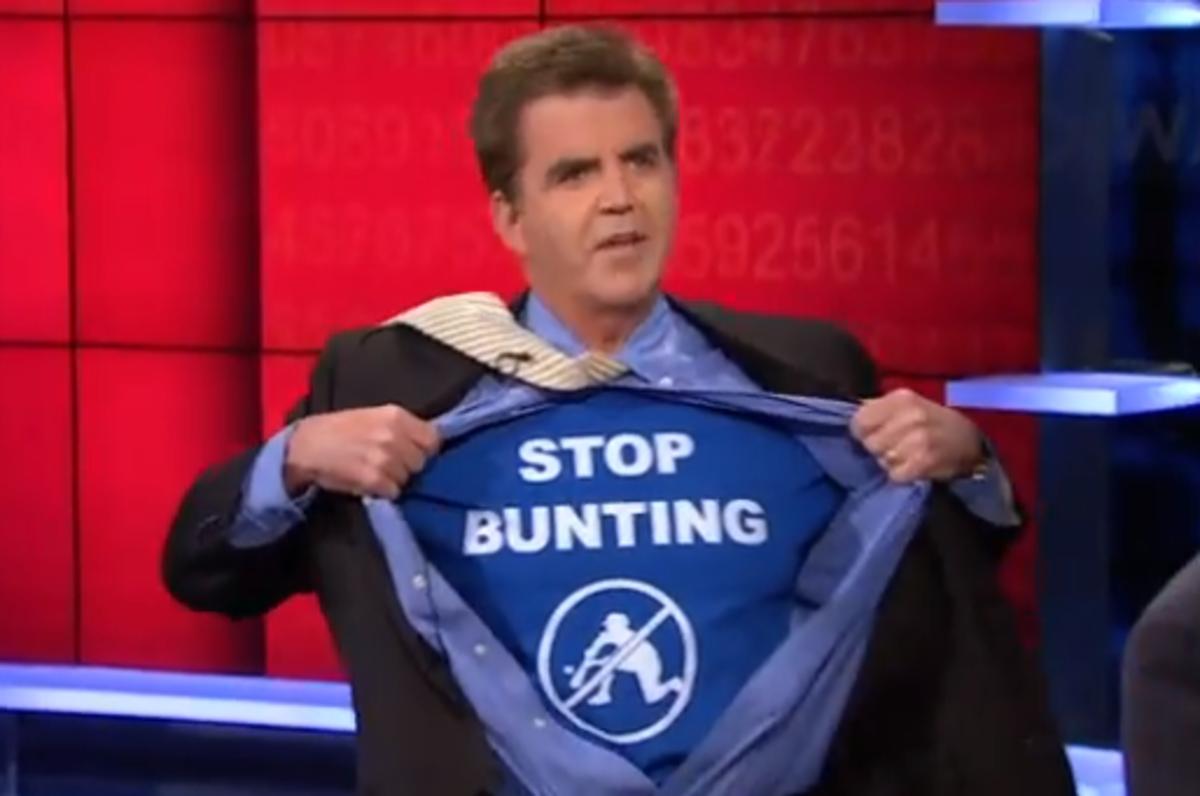Bunting for Dummies
I don't hate bunts. What I hate are wasted outs. What I hate are wasted opportunities.
Outs are precious things, and though I'm no math major, I'm confident in the knowledge that three of a precious thing is 50 percent better than two of of any such thing; not just in a particular inning of a baseball game, but universally the world over. It's called "sacrifice" for a reason, sports fans.
So yes, I'll come right out and say it: To a degree, if you're bunting, you're a dummy. What follows is for you, dummy.
Doctrine: Bunting-for-Dummies (BFD):
1. Don't bunt.
2. If you must bunt - to advance a runner - bunt a damn strike. If in an effort to prevent your sacrifice, a pitcher is coming up and in, don't make his job easier by offering at a bad ball. Make the man throw strikes. Bunt a buntable baseball. This is a Little League principle that, unfortunately, must be preached at the big league level. Obvious exception: a squeeze play.
3. For National League pitchers especially: You're going to be asked to bunt, so you might as well learn the skill. There is no excuse for an NL starter to be lacking in this department. You want to win games, guys, learn to bunt.
4. If you must bunt, NL starter, bunt like Clayton Kershaw. See photo above. Make the catcher chase the baseball so that there is zero chance of an out anywhere other than at first base.
[Follow Sports Illustrated’s Inside the Dodgers on Twitter.]
5. Dear managers, teach your pitchers to bunt. Teach it during winter workouts, if you are so lucky to call a warm weather city home. Teach it during Spring Training. Give special attention to those who need it. Practice during the season. We're talking about practice. Drill baby drill!
5a. Dear Dave Roberts, you were a great bunter in your day and have another great bunter in Maury Wills available for instruction. Teach Walker Buehler to bunt. It's not that complicated. He's one of the worst bunters you've ever seen. He's a .118/.167/.147 lifetime hitter with a grand total of five sacrifice bunts in two full seasons, and he was lucky to get those. He ought to welcome your effort.
6. Dear managers, know your position players. Don't ask men who can't bunt to bunt. Don't give the opponent free outs. And sorry if this sounds condescending - which it is - don't allow a man who can't bunt to bunt into an infinitely predicable double-play. And, for God's sake, if for some reason you ask a man who can't bunt to bunt and he fails miserably but manages only strike one instead of something worse, call off the damn bunt.
6a. It's not every day that a bad bunter like Juan Uribe will be asked to bunt - twice! - with a warmed and ready closer twiddling his thumbs in the bullpen, only to bail out his skipper with a three-run home run. In October.
7. Bad hitters who may be good bunters may bunt. If you have a hitter like Eugenio Velez in the lineup, for example, a sacrifice is infinitely better than a strikeout, or worse, a one-pitch out. Or worse, one pitch and two outs. And oh, by the way, can you guess how many sacrifice bunts Velez recorded during his 0-37 partial season of 2011 in Los Angeles? Yep, none. Zero, zilch, nada. I'm talking to you, Don Mattingly, you bunting maniac!
7a. Note: It got to such the point during Mattingly's five years in L.A. that I could predict his bunting boners innings in advance. And if I could predict them, so could the opposing manager.
8. Bunting for a hit is an entirely different animal. But skilled bunters only. Rafael Furcal, with his little slap technique (see below), was a great bunter. As a leadoff hitter, his job was to get on base any way possible. You have a skill like that, you have a lifetime on base percentage of .348 (and .351 as a Dodger), knock yourself out.
If you are Brett Butler, who it is only a slight exaggeration to say could get on base with a walk or a bunt single any time he liked, with a lifetime .377 OBP (and .392 as a Dodger), knock yourself out.
9. Dear managers, with a runner at second to lead off an inning and almost any hitter not named Velez at the plate, do not bunt. Do. Not. Bunt. Take your three shots at a run. Or better yet, more than a run.
10. Stop bunting!

11. Understand the distinction that advancing a runner via the sacrifice bunt is not necessarily a "successful" occurrence. Yes, that sacrificer gets an "SH" in the record book, but the outcome is only a success if the advanced runner comes around to score.
Advancing a runner via the sac bunt is not a "success;" it's an "execution." And I am reminded of the late great coach John McKay, who when asked in 1976 about his 0-14 Tampa Bay Buccaneers' execution, said, "I'm in favor of it."
12. A team's opportunities to score one or more runs with three precious outs > with < three precious outs. Hence, 3 > 2. Always. Please make a note of it.
And remember, glove conquers all.
Howard Cole has been writing about baseball on the internet since Y2K. Follow him on Twitter.
